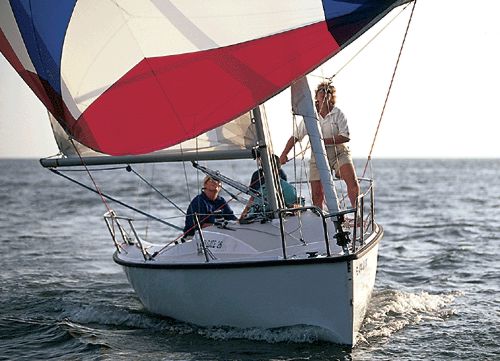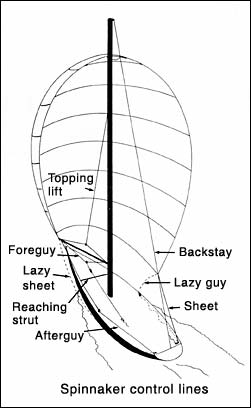The Spinnaker - Jibing Techniques
Part 5 of the Spinnaker Series
 There are two basic jibing techniques: the end-for-end jibe, used most often on small boats; and the dip-pole jibe used on larger racing and cruising boats.
There are two basic jibing techniques: the end-for-end jibe, used most often on small boats; and the dip-pole jibe used on larger racing and cruising boats.
In the end-for-end system, as the boat heads down, for example, from a starboard tack reach in order to jibe, the pole should come aft and the sheet should be eased. The boat is on a dead run at the instant of jibing and the spinnaker should be trimmed for that point of sailing. The main boom and spinnaker pole should then be jibed over and the boat should head up to the new port tack reach. The pole should be forward near the jibstay and the sheet trimmed in.
During the jibe, the foredeck crewman on a boat such as the Colgate 26 (pictured at right, click to enlarge) stands against the mast facing forward. From this position he has the best leverage for controlling the pole and getting it off the mast. Also, he can see the spinnaker and help keep it full. On a reach-to reach jibe, he should take the pole off the mast and then off the "old" guy. This makes the spinnaker freewheeling and the mid-cockpit crew can pull the spinnaker around the boat without the pole's restricting it in anyway. The foredeck crew then connects the end of the pole that was previously at the mast to the "new" guy and snaps the other end of the pole into the mast fitting. This is called "end-for-ending" the pole.
Usually the skipper will turn the boat through the jibe smoothly and evenly, keeping the spinnaker full. The one exception to this is in doing very-light-air, reach-to-reach jibes. On the initial reach, the apparent wind is forward and the boat speed greater than it possibly could be downwind. As the boat turns into the jibe, the spinnaker collapses because the momentum of the boat overruns the spinnaker. This makes it very difficult to ease the sheet to get the spinnaker around to the other side of the boat because there's no wind in the sail and no pull on the sheet. The solution takes timing, but is worth practicing. Just as the boat arrives at the mark to be rounded, while the spinnaker is still full on the reach, release the sheet and square the pole. At the same instant turn the boat fast to the new reaching course. The spinnaker collapses (as it would anyway), but it is around the jibstay to the new leeward side, Quickly shift the pole to the new windward side, and you begin sailing with the spinnaker full on the new reach having hardly even slowed down.
A running jibe is much easier. The boat's heading changes only slightly, so all we are doing is changing the pole from one side to the other while keeping the spinnaker full. Again, the foredeck crew braces their back against the mast, with feet spread apart for balance while handling the pole. They should grab (or be handed) the old sheet and bring the sheet in to the mast, so that the pole remains out to windward as long as the wind is on that side of the boat. Snapping the pole off the mast and into the new guy, they then pushes the pole out to the new windward side (tripping the old guy out in the same motion) past the mast, to help the spinnaker over to the new weather side of the boat before bringing the pole end back to snap into the mast. Thus, the foredeck crew can help keep the spinnaker full during the jibe. In light winds the skipper should hold the main boom in the middle of the boat briefly to keep the spinnaker full while the pole is transferred to the other side.
On larger sailboats, the spinnaker pole is too heavy to take completely off the mast and end-for-end, so a dip-pole technique, in which the pole remains attached at the mast, is used. In this system, the mast end of the pole is raised up on its mast slide to enable the other end of the pole, which has been detached from the spinnaker guy, to dip down sufficiently to clear the headstay. Then it is attached to the new guy and hoisted again, and the topping lift and downhaul are secured when the pole is at the proper height.
On ocean racers, the spinnaker is sometimes equipped with double guys and sheets. The secondary lines are called the "lazy guy" and "lazy sheet,' because they are not used until jibing. In the jibe, the lazy guy and sheet are trimmed so that they take the full pull of the spinnaker. A crewmember then pulls the lanyard that opens the jaw of the pole and releases it from the after guy. This is called "tripping the guy." The topping lift is eased and the pole swings down. The foreguy is trimmed to bring the pole to the center of the boat where another crewmember waits with a loop of the new guy to snap into the jaw of the pole as it swings down inside the headstay. When the new guy has been snapped into the pole end, the foredeck crew yells, "Made," which is the signal for the topping lift to be pulled to lift the pole back to a level position, the foreguy eased and the new guy trimmed, pulling the pole end out to the tack of the spinnaker. The coordination of the crew on the topping lift and foreguy keep the pole under control at all times during the jibe. With the strain now on the new guy and sheet, the lazy guy and sheet are relaxed to wait for the next jibe. With this method, properly executed, the spinnaker never collapses during a jibe, so no speed is lost.
When you don't have the benefit of time for the jibe and conditions are howling, change the timing of the jibe. Let's say you're in an around-the-buoys race, running in 25- to 35-knot winds and rolling madly. Jibe the mainsail first. Get it over, vanged down, with a preventer holding it forward and your running backstay set and tight before you jibe the spinnaker. Then jibe the spinnaker pole over. You'll find this a much better system than jibing both main and spinnaker at the same time or even jibing the spinnaker first followed by the main. Even thought they're all hairy, this system will provide more control than the other.
One other jibing method should be kept in mind for use under vicious wind conditions - the twin-pole jibe. With this system, you set a second pole to leeward so that the spinnaker is completely stabilized before you jibe the mainsail. After jibing, you take down the original pole, which is now to leeward. This type of jibe is commonly used in larger boats that can afford to carry the weight of a spare spinnaker pole. The wind would probably be in excess of 30 knots and/or the crew shorthanded to need to use this system. And, lastly, time must not be a factor. An ocean race, where a strategic jibe is called for but doesn't have to be done quickly, is made to order for a twin-pole jibe.
Occasionally pandemonium reigns on the foredeck during a spinnaker jibe, and often the foredeck crew, who is all wrapped up in spinnaker cloth, lines, etc., is the butt of abuse when actually the fault lies with the helmsman. The skipper who turns the boat too sharply and who gives the crew inadequate directions or time to react will almost certainly cause a bad jibe. In heavy air, the helmsman must be sure to counteract the tendency for the boat to round up into the wind right after the jibe. The boom swings over with great force and, when it reaches the end of the mainsheet, it stops abruptly and the sail presents a wall to the wind, Something has to give until an equilibrium is found, so the boat heels over and a strong weather helm results. The forces in the sail out over the water turn the bow of the boat toward the wind. This combination will cause a broach in heavy air unless the helmsman heads the boat off decisively to meet the anticipated turning moment. However, if the jibe is done properly, the boat, although being steered as if to jibe back again, sails straight ahead. Nothing can make a crew look worse than bad helmsmanship.
Reprinted from "Steve Colgate on Sailing."
By Steve Colgate, Published by W.W. Norton & Co.
Steve Colgate is the founder of Colgate Sailing Schools, with locations in Tortola BVI, Captiva Island FL, Duck Key FL, St. Petersburg FL, Chelsea Piers NY, Liberty Landing NJU and Newport RI.
Offshore Sailing Schools
16731 McGregor Blvd.
Fort Myers, Florida 33908
1-888-454-8002
239-454-1700
Fax: 239-454-1191
e-mail: [email protected]
www.offshoresailing.com












